Essential Pet Grooming Routines in the UK
Keeping pets clean and healthy requires consistent pet grooming routines tailored to their unique needs. In the UK, pet grooming best practices recommend daily brushing for dogs and cats with medium to long fur to prevent matting and remove loose hair. Short-haired breeds benefit from weekly brushing to control shedding. Small animals like rabbits and guinea pigs need gentle grooming routines focused on maintaining coat cleanliness without stressing them.
UK pet care advice stresses the importance of adjusting grooming frequency based on breed and season. For example, during wet, muddy UK winters, more frequent bathing and coat checks are necessary to avoid skin infections. Conversely, in summer, focus on keeping coats free of tangles and checking for parasites like fleas and ticks—common in the UK’s climate.
Also read : How do you find a reliable vet in the UK?
Techniques should always be gentle to protect sensitive skin, using brushes appropriate for the pet’s coat type. Regular ear and paw inspections are vital parts of routines, as these areas can harbor infections or irritants. Applying UK-specific guidelines ensures grooming not only looks good but supports overall pet wellbeing throughout the year.
Legal and Welfare Considerations for Pet Grooming
Pet grooming in the UK is governed by strict UK animal welfare laws that ensure the humane treatment of animals during grooming sessions. The Animal Welfare Act 2006 mandates that pet owners and groomers provide care that prevents suffering, covering grooming practices to avoid causing distress or injury.
Also read : How can you find the best UK pet boarding services?
The RSPCA grooming guidelines emphasize gentle handling and the importance of obtaining the animal’s consent by observing signs of stress or discomfort. These guidelines align with pet grooming regulations that require the use of safe grooming tools and adherence to recognized standards, especially for sensitive areas like ears and paws.
Professional groomers and owners alike should be aware that failure to comply with these regulations can result in legal consequences. Humane treatment is not optional but a legal obligation, and grooming must be adapted to each animal’s temperament and health status.
By understanding and following pet grooming best practices UK, pet owners ensure not only cleanliness but also the well-being and dignity of their pets. Respecting these UK animal welfare laws protects animals and fosters trust between pets, owners, and professionals in the grooming community.
Recommended Tools and Products for UK Pet Owners
Choosing the best pet grooming tools UK is essential for effective and safe grooming. For dogs and cats, appropriate brushes vary by coat type: slicker brushes for long-haired breeds, bristle brushes for short-haired, and combs to detangle mats gently. Clippers designed for pet fur speed grooming without causing discomfort. For small animals, soft-bristled brushes prevent skin irritation.
When selecting recommended pet shampoos, UK pet owners should prioritise products formulated for sensitive skin, free from harsh chemicals, and approved under UK animal care standards. Hypoallergenic shampoos benefit pets prone to allergies, supporting skin health during regular washes.
In addition to tools and shampoos, essential grooming kits often include nail clippers, ear-cleaning solutions, and grooming gloves to remove loose fur. Using the correct equipment aligns with pet grooming best practices UK and enhances grooming efficiency while ensuring animal comfort.
Considering pets with sensitive skin or allergies, owners must avoid products containing artificial fragrances or dyes. Consulting UK-specific pet care advice helps identify grooming supplies tailored to individual animal needs, reducing risks of irritation or adverse reactions.
Seasonal and Breed-Specific Grooming Advice
Seasonal changes greatly impact pet grooming routines in the UK, demanding adjustments to maintain pet comfort and health. During wet, muddy winters typical in the UK, more frequent grooming is necessary to remove dirt, prevent matting, and reduce the risk of skin infections. For example, long-haired breeds like Afghan Hounds require extra brushing to prevent tangles exacerbated by damp conditions, while short-haired breeds benefit from regular wiping to keep the coat clean.
In warmer months, shedding increases for many dogs and cats, requiring enhanced grooming to control loose fur and avoid overheating. Breed-specific grooming UK guidelines emphasize tailoring routines to coat types—double-coated breeds need de-shedding techniques, and delicate-skinned pets require gentle handling to avoid irritation.
UK pet care advice also recommends vigilant parasite checks year-round, especially after outdoor exposure, as fleas and ticks are common with changing seasons. Recognizing and adapting grooming frequency and technique according to season and breed aligns with pet grooming best practices UK, ensuring pets remain healthy, comfortable, and clean throughout the year.




